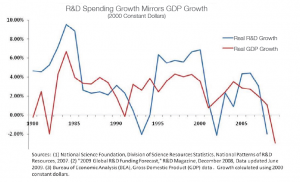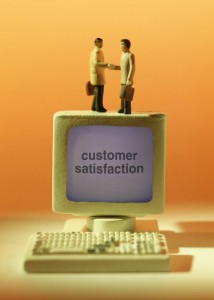 New product forecasting is not new itself at all. It has been around for decades. However, the speed of new product releases and the subsequent product lifecycle have changed radically with the advent of advancing technology and more sophisticated consumer demand. Think about it: the color television was introduced in 1954, and did not go ‘main-stream’ until 1964. 10 years! Now, fast forward 60 years. Since 2001, a little over a decade ago, the following were a few new products that were introduced: the Apple iPod, Hybrid cars, Bluetooth earpieces, and satellite radio. The pace is at break-neck speed and not slowing down.
New product forecasting is not new itself at all. It has been around for decades. However, the speed of new product releases and the subsequent product lifecycle have changed radically with the advent of advancing technology and more sophisticated consumer demand. Think about it: the color television was introduced in 1954, and did not go ‘main-stream’ until 1964. 10 years! Now, fast forward 60 years. Since 2001, a little over a decade ago, the following were a few new products that were introduced: the Apple iPod, Hybrid cars, Bluetooth earpieces, and satellite radio. The pace is at break-neck speed and not slowing down.
New Product Proliferation
Why the proliferation of new products? Here are some of the most important reasons for the increase in new product introductions:1
• Growth companies show a greater investment in new products over existing products.
• New product introduction correlates with a larger market share, while the market share of older products is impacted by competitive challenges and dwindling customer interest.
• Companies are increasingly dependent on new product revenues to drive their top lines every year.
• New products allow companies to grow revenues and retain high margins by creating new customers in new markets.
• Even when a company’s top line isn’t increasing, it needs new products to replace existing products that are reaching end-of-life.
• New products drive growth, which drives value, and high valuations allow companies to raise capital, acquire competitors, and attract the best talent.
• Companies with a robust R&D strategy are statistically 73% more profitable. See the chart below for a look at the correlation between R&D spending and GDP growth.

Profits Reflect R&D Investments
Not surprisingly, new product revenue as a percentage of total sales is on the rise, with recent figures placing the number at over 30%.2 Grocery stores, for example, add an average of 10,000 more SKUs a year, and then optimize profitability down to a shelf level, escalating the pressure for accurate demand forecasting on manufacturers and their suppliers.2 With that, however, new product forecast error within the first 6 months is about 50%, or twice that of the error for a baseline SKU.2 After all of the painstaking work to develop, launch, and build forecasts for those products, 70 to 80% of them fail in the first 10 years.2 I believe that most people think like I do: We can do better than this!
New Product Forecasting – How is it Unique?
New product forecasting is more complicated than for established products, primarily due to the lack of historical data that is the foundation of most models. There is no long time series of data or the accompanying trajectory from the past demand on which to base future demand. The forecasting accuracy, though, is even more important with new products, as getting it right from the outset can be key to future sales, in a kind of snowball effect. Lost sales that result from an underestimation of demand could lead to the loss of future revenue stream from the loss of related sale of accessories, maintenance contracts, spare parts, and complementary products.1 Even worse, the competition can step in to take the market share that is left on the table. This ripple effect makes it even more important to come out of the gate with the best possible new product forecast accuracy.
Evolution of New Product Forecasting Methodologies
I took a look back in time at how new product forecasting has evolved. I was surprised that a lot of the practices and techniques used today were used as far back as over 40 years ago. As far back as the 1970’s, experts in the field already recognized that forecast accuracy was key to new product profitability. These sources expressed that their concerns for the forecast were not just in demand, but in what could become changes to the product profitability and lifecycle. Back then, the methods they recommended, ordered by estimated quality of the results, were qualitative in nature, based on expert opinion, and often done without a computer3:
• Market Research: Consumer data gathered via questionnaires, surveys, and any available analysis. Viewed as the best of the methods.
• Delphi: Expert panel interrogated with questionnaires. Originally introduced in the 1940s. Anonymity used to reduce biases.
• Historical Analogy: Comparative analysis of introduction and growth of similar new products.
• Visionary Forecast: – Personal insights, judgment, available facts analyzed based on past events. Viewed as the least scientific of all methods.
Believe it or not, these same methodologies are still being used today, albeit in a more automated form. Aided by the digital age, a big shift has been in the expansion of the Market Research category. Some of the new market research techniques are:4
• What-if and scenario analysis is now done to gauge consumer reaction before traditional forecasting methods are employed.
• Estimates are based on outgrowth of old products, as a substitute for an existing product, or on the basis of a pattern of growth of an established product. But these are now refined with sample sales, surveys, market penetration analysis, and the use of knowledgeable dealers with greater customer knowledge and interaction.
• Demand experiments, as they are called, are now more widely conducted on a small group of customers, with the results extrapolated to a larger population. For example, marketing firms will often test a new consumer product in a geographically isolated “test market” to establish its probable market share. This experience is then extrapolated to the national market to plan the new product launch.
Best Practices
Armed with the methodologies above, best practices will help you achieve the best new product forecasting. Here are some guidelines that I recommend:
• Build a time and monetary commitment, with full support from the C-suite, and try to reduce competitive and bias forces between departments.
• Use forecasting data sources that bring the forecaster as close to the consumer as possible. Methods beyond surveys can include demos, focus groups and forums, and product demonstrations. Structure market analysis to remove as much subjective data as possible.
• Use a variety of methods throughout the product development process to develop a better forecast, and use continuous improvement to refine.
• As always, manage uncertainty with risk mitigation techniques, especially for those new products that don’t have the benefit of a ‘like’ product with which to obtain historical forecasting data.
My Takeaways
1. Innovative products keep your revenues strong, increase your market share, and grow your business.
2. New product forecasting is becoming more important than ever with shortening lifecycles and proliferation of new products in many industries, from manufacturing to high tech to food to retail.
3. The correct forecasting framework for process, people, and technology, becomes even more important with new product inherent difficulties of lack of historical data, biases of judgment data, and errors introduced with consumer surveys.

Yogi Berra
New products are at the core of the leading companies, and the old adage ‘Change or Die’ fits here very well. The investment made in new products from R&D to manufacturing to distribution requires follow-through in demand forecasting to have a success story that can further a company’s revenue. Profit and growth result from better supply chain effectiveness, reduced labor costs, optimum cash flow, and high levels of customer satisfaction. But the success stories do more than just drive the bottom-line: they can further a company’s very brand identity. Remember the new products at the beginning of the blog? I am betting that the forecasting efforts behind the scene played a large part of the ultimate success of all of those new products. In taking a look at the methodologies here, I think that was no easy task! But in the face of these challenges and uncertainties, it’s good to laugh once in a while. As Yogi Berra once said, “It’s tough to make predictions, especially about the future.”
Add your comments to the conversation! I would love to hear your feedback and lessons learned.
References:
1. Singh, Mahender, ESD 260 Lecture, September 20, 2006. http://ocw.mit.edu/courses/engineering-systems-division/esd-260j-logistics-systems-fall-2006/lecture-notes/lect5.pdf
2. “Achieving Excellence in New Product Forecasting”, July 30, 2013, IBF Supply Chain Forecasting and Planning Conference 2013. http://www.youtube.com/watch?v=13pfATXlXeU
3. John C. Chambers, Satinder K. Mullick, and Donald D. Smith, “How to Choose the Right Forecasting Technique”, Harvard Business Review Magazine, July 1971. http://hbr.org/1971/07/how-to-choose-the-right-forecasting-technique/ar/4
4. “Three Simple Methods for NPD Sales Forecasting (Methods)”, Global NP Solutions. http://www.globalnpsolutions.com/services/npd-resources/white-papers/three-simple-methods-for-npd-sales-forecasting-intro/methods/
Image “Time for Innovation” courtesy of Stuart Mills / FreeDigitalPhotos.net.
Image graph courtesy of “R&D Spending Slows”, http://freemarketmojo.wordpress.com/2009/10/22/rd-spending-slows/
Image “Yogi Berra” courtesy of Gary Bedingfield / http://www.baseballinwartime.com/player_biographies/berra_yogi.htm
 My last 3 blogs have gone into elaborate detail about New Year recommendations for supply chains – I’d like to summarize and give a final ‘tip sheet’ on my take for supply chain recommendations for all 3 categories I reviewed. The categories are profitable proximity, risk management, and customer focus. As presented before, my launching point was the supply chain trend predictions as offered by 4 groups: Gartner Analysts, IDC, Ferrari Group, and SupplyChainBrain. I looked at our client and other industry experiences as relating to all the trend predictions, and created a ‘best of’ list of supply chain recommendations to get you off to a competitive start that is measurable and offers a critical return on your investment. As I alluded to, I believe that if you are going to prioritize only one of the three areas, I would choose customer focus.
My last 3 blogs have gone into elaborate detail about New Year recommendations for supply chains – I’d like to summarize and give a final ‘tip sheet’ on my take for supply chain recommendations for all 3 categories I reviewed. The categories are profitable proximity, risk management, and customer focus. As presented before, my launching point was the supply chain trend predictions as offered by 4 groups: Gartner Analysts, IDC, Ferrari Group, and SupplyChainBrain. I looked at our client and other industry experiences as relating to all the trend predictions, and created a ‘best of’ list of supply chain recommendations to get you off to a competitive start that is measurable and offers a critical return on your investment. As I alluded to, I believe that if you are going to prioritize only one of the three areas, I would choose customer focus.  1. Using the newest profitable proximity guidelines, design a network that makes the most sense for your organization.
1. Using the newest profitable proximity guidelines, design a network that makes the most sense for your organization. 1. Identify all risks, including disasters, economic, human resources, customer demand, and never overlook: your competitors!
1. Identify all risks, including disasters, economic, human resources, customer demand, and never overlook: your competitors!  1. Build a talented supply chain team that will innovate for the customer’s needs and collaborate internally to build brand loyalty, and design your supply chain with demand volatility and customer satisfaction in mind. See if supply chain segmentation can turn your customer focus into supply chain success.
1. Build a talented supply chain team that will innovate for the customer’s needs and collaborate internally to build brand loyalty, and design your supply chain with demand volatility and customer satisfaction in mind. See if supply chain segmentation can turn your customer focus into supply chain success. Will these supply chain recommendations be evergreen, or be surpassed by different ones next year due to shifting environments and priorities? Only time and experience will tell. For now, differentiate yourself from your competitors by being proactive and addressing the top supply chain problems.
Will these supply chain recommendations be evergreen, or be surpassed by different ones next year due to shifting environments and priorities? Only time and experience will tell. For now, differentiate yourself from your competitors by being proactive and addressing the top supply chain problems.











